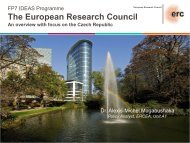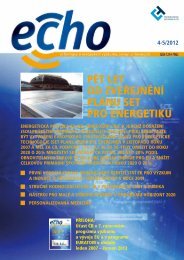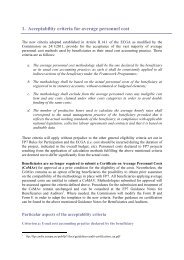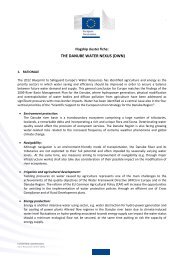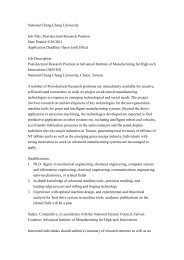Guide to Research and Innovation Strategies for Smart Specialisation
Guide to Research and Innovation Strategies for Smart Specialisation
Guide to Research and Innovation Strategies for Smart Specialisation
You also want an ePaper? Increase the reach of your titles
YUMPU automatically turns print PDFs into web optimized ePapers that Google loves.
side of the box provides a typology which most concisely captures the major features associated<br />
with each of the individual Europe2020 challenges 28 .<br />
For the purposes of this guide, the classification scheme used here is meant <strong>to</strong> be indicative<br />
rather than definitive, <strong>and</strong> schematic rather than exhaustive, <strong>and</strong> in particular cases other<br />
classification schemes may be more appropriate.<br />
For the Europe 2020 smart growth typology, the most concise framework is provided by the<br />
OECD (2011) regional innovation typology in which regions are grouped in<strong>to</strong> three broad types,<br />
namely knowledge regions, industrial production zones, <strong>and</strong> non-Science & Technology -driven<br />
regions, within which there are various sub-categories. These three broad categories reflect the<br />
major observed differences in terms of the relationships between knowledge, innovation <strong>and</strong><br />
regional characteristics. EU regions can be classified in<strong>to</strong> one of these broad smart growth<br />
groupings in terms of the role played by knowledge in fostering their local innovation processes.<br />
For the Europe 2020 sustainable growth typology the classification scheme which most concisely<br />
captures the different combinations of environmental <strong>and</strong> energy challenges is based on the<br />
relationship between the built environment <strong>and</strong> the natural environment. At its most fundamental<br />
level, this gives us four types of regions, namely regions which in nature are primarily rural<br />
regions, rural near urban regions, urban regions, <strong>and</strong> urban-coastal regions. 29<br />
For the Europe 2020 inclusive growth typology, the classification scheme which most concisely<br />
captures the very different social inclusion issues faced by regions is that which is also adopted<br />
by the ESPON (2010) DEMIFER project. This has two broad types of regions, namely regions<br />
facing population decline <strong>and</strong> population outflows <strong>and</strong> regions facing population growth <strong>and</strong><br />
population inflows. Migration is a highly selective phenomenon <strong>and</strong> mobility is highly correlated<br />
with skills <strong>and</strong> income. Population outflow regions are generally facing combinations of both<br />
more rapid population ageing <strong>and</strong> also economic decline, <strong>and</strong> in turn these have significant<br />
adverse impacts on both innovation <strong>and</strong> environmental issues.<br />
In Figure 6, each individual axis represents one of the three Europe2020 agenda dimensions. The<br />
combination of the smart growth, sustainable growth <strong>and</strong> inclusive growth typologies allows <strong>for</strong><br />
twenty-four possible tripartite types of place characteristics, each of which is reflected by a<br />
different cell in the three-dimensional box of regions.<br />
28 The regional categories depicted by the sides of the box diagram here with regard <strong>to</strong> the smart growth, sustainable<br />
growth <strong>and</strong> inclusive growth dimension of Europe 2020, are exactly the same categories as those used in<br />
results/outcome indica<strong>to</strong>rs classification scheme adopted by the international panel of experts advising the EU<br />
Commissioner <strong>for</strong> Regional Policy Johannes Hahn the Direc<strong>to</strong>rate General <strong>for</strong> Regional Policy on the use of<br />
results/outcome indica<strong>to</strong>rs within a re<strong>for</strong>med Cohesion Policy.<br />
29 This sustainable growth classification scheme of primarily urban, primarily rural near urban, primarily rural <strong>and</strong><br />
primarily urban <strong>and</strong> coastal, closely resembles the OECD (2011b) regional typology based on the dominant builtenvironment-natural<br />
environment features which uses three types of regions, namely predominantly urban regions,<br />
predominantly intermediate regions, <strong>and</strong> predominantly rural regions, respectively, with one additional category<br />
here of an urban <strong>and</strong> coastal region, common in Europe.<br />
47



